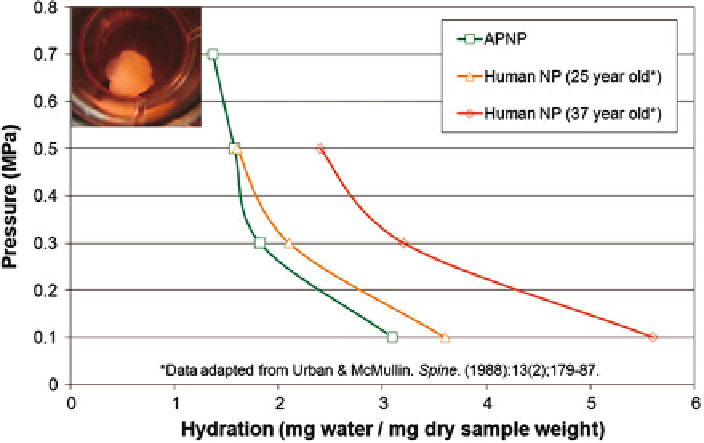Biomedical Engineering Reference
In-Depth Information
Fig. 4
Insert
: Representative macroscopic image of an APNP hydrogel scaffold seeded with
human adipose-derived stem cells following 7 days of culture in a 12-well plate.
Graph
: Osmotic
swelling pressure profile of APNP hydrogel scaffolds (
green-squares
) compared to human NP
(
orange-triangles
and
red-diamonds
) values found in the literature [
28
]
We have also shown that these scaffolds generate an osmotic swelling pressure
profile (Fig.
4
) that mirrors that of a 25-year-old human and that they are conducive
to repopulation with human ADSC [
28
,
113
].
Le Visage et al. investigated the use of small intestine submucosa, an ECM
composed predominantly of type I collagen, GAGs, and growth factors, which
they hypothesized would provide an attractive substrate for disc cells [
116
]. Fol-
lowing 3 months in standard cell culture conditions, human NP cells (obtained from
degenerated discs) attached and migrated into the scaffolds and remained meta-
bolically active, as determined by histology. Dimethyl-methylene blue (DMMB)
assay indicated that control scaffolds (without cells) slowly lost their original GAG
content, but that scaffolds seeded with NP cells steadily gained significant amounts
of GAG with an average increase of 40%. This was confirmed by toluidine blue
staining, which showed large areas of sGAG not observed in control scaffolds.
Ultimately however, cells began to die at the 2 and 3 month time-points, and gene
and protein expression for aggrecan, collagen type II, and Sox-9 were not represen-
tative of active NP cells.
8.2.4 Alginate-Based Scaffolds
Due to its similar structure to chondroitin sulfate and its ability to absorb 200-300
times its weight in water, many investigators have hypothesized that this brown

